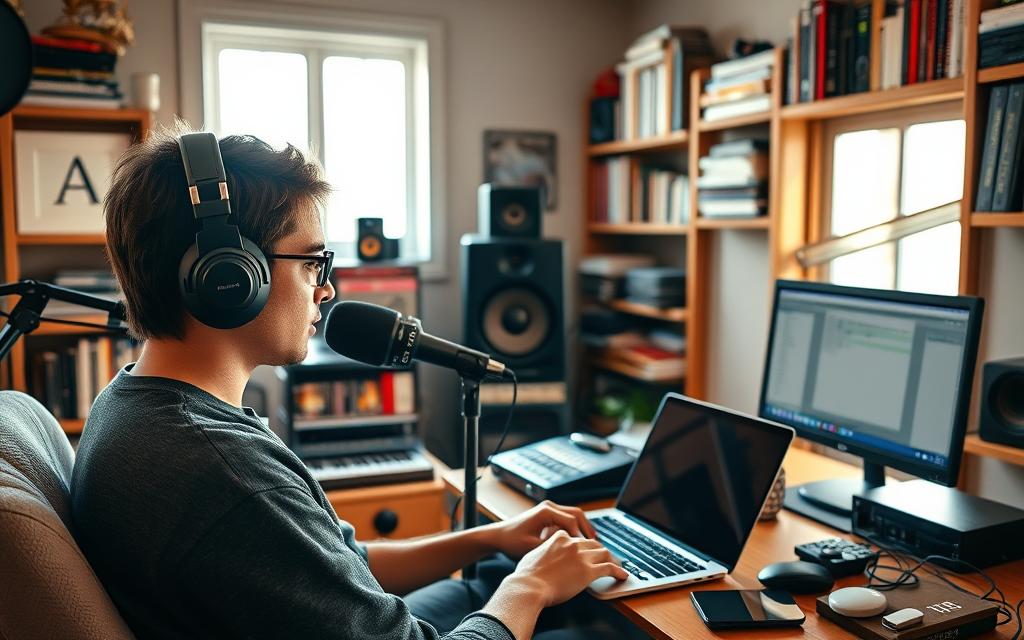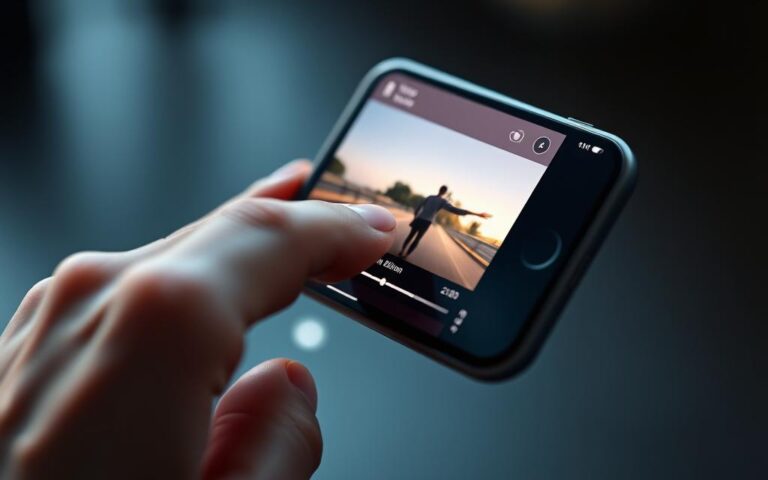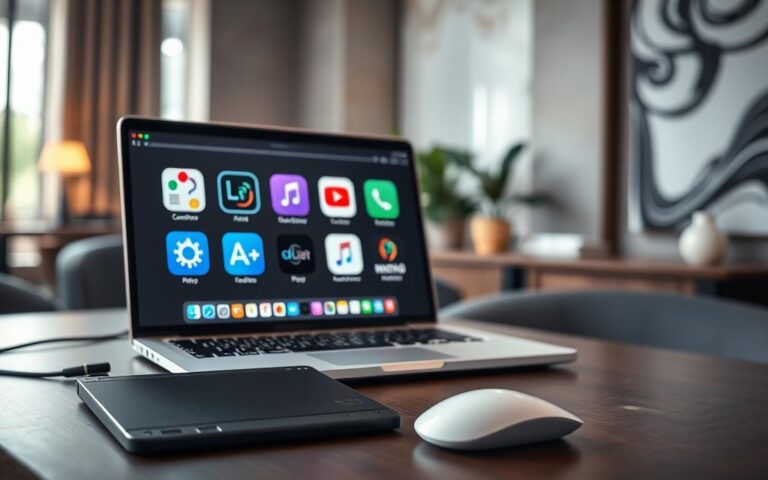More than half of people in the U.S. have tuned into a podcast. This fact shows the big chance podcasts have in the online world. Now, with a smartphone, anyone can create a podcast. It opens up chances for everyone to get into making content. No matter if you love telling stories, know a lot about something, or want to share thoughts, starting a podcast on your phone is simple.
This guide will show you key tips for starting your own podcast. You’ll learn how to use your phone and some cool apps for recording and editing. We’ll show you everything needed to turn your voice into an engaging podcast. Get excited to share your unique ideas with the whole world, using just your phone.
Understanding the Basics of Podcasting
Today, people are always looking for content to enjoy while they’re on the move. Podcasts are super popular for this reason. They are audio shows that grab the listener’s attention and share interesting info. Getting what podcasts are is key for anyone wanting to make one.
What is a Podcast?
A podcast is all about spoken words or audio episodes. These focus on certain subjects or stories. Creators love them because they can explore what they love. Plus, people find them easy to listen to whether for learning or fun.
Benefits of Podcasting
Podcasting comes with lots of perks. It creates a strong bond with listeners. This is due to its personal and engaging storytelling style. Podcasters can also cover various topics, spreading their reach far and wide. Since you can listen to them anytime, they’re perfect for those with busy schedules.
Key Elements of a Successful Podcast
To have a hit podcast, there are a few essential things you need. First, your podcast needs a clear theme that speaks to your audience. Posting new episodes regularly keeps your listeners coming back. High-quality sound matters too, as it makes listening enjoyable. Lastly, promoting your podcast will bring in more listeners.

Choosing the Right Equipment
Starting a podcast with a smartphone means you need the best gear for clear audio. The latest podcast gear for smartphones offers lots of choices. This section talks about the gear you need, great microphones, and editing apps that make your podcast better.
Essential Gear for Smartphone Podcasting
Getting the basics right is key for a good podcast. You’ll need:
- A quality microphone to ensure clear audio.
- Headphones for monitoring sound during recording.
- Optional portable recorders for added flexibility.
Recommended Microphones and Accessories
Finding the right microphone can make your audio sound clear. Here are some top picks:
- Shure MV5: It’s durable and has excellent sound quality.
- Rode VideoMic Me: Great for smartphones and captures high-quality audio.
Add windshields and portable stands to these mics for the best sound.
Apps for Editing and Recording
Several podcast editing apps are great for making your podcast sound professional. Some include:
- Anchor: Perfect for beginners with its easy-to-use setup.
- GarageBand: For those who want advanced editing tools.
- Audacity: A free app that works on many devices and is very powerful.
These apps will improve your recording and editing, making your podcast sound great.
Selecting Your Podcast Topic
Choosing the right topic for your podcast is key in building your content strategy. Start by figuring out your podcast niche. Focus on areas you’re passionate and knowledgeable about. This will help you stand out.
Identifying Your Niche
It’s crucial to know your podcast niche to make content that listeners love. Think about what interests you and what you know well. Here are some questions to ponder:
- What topics excite you the most?
- What knowledge do you possess that others may find valuable?
- Where do you see gaps in existing podcast content?
Tips for Brainstorming Ideas
Coming up with podcast ideas takes creativity and research. Try these methods:
- Mind mapping to see how topics connect.
- Looking at what’s trending in various media.
- Checking out current podcasts to find missing content opportunities.
Researching Your Audience’s Interests
Understanding what your audience likes is crucial. Use surveys, social media polls, and analytics to learn about their interests. This helps you make your podcast relevant and engaging. It’s a great way to build a dedicated group of listeners.
Planning Your Podcast Format
Starting a successful podcast means thinking carefully about your format. This choice affects not just what you talk about but also how listeners connect with your show. Pick a format that fits your topic and meets your audience’s expectations.
Types of Podcast Formats
There are many podcast formats to choose from. This means you can find one that matches your personal style. Popular types include:
- Interview-Based: Feature guest experts or influencers sharing insights.
- Narrative: Craft compelling stories with a focus on storytelling formats.
- Solo Commentary: Share personal thoughts, opinions, or expertise.
- Educational: Provide valuable information on a specific subject.
Creating a Show Outline
An effective podcast outline keeps your episodes on track. It helps you hit all the important points without straying. Think about organizing your outline with main topics, bullet points for details, and questions to spark discussions.
Establishing Episode Length
Choosing how long each episode should be is key to keeping listeners. Most successful podcasts last from 20 minutes to an hour. This length is great for sharing good content without tiring your audience. Stay consistent with your episode length to keep listeners coming back.
Recording Your Podcast
Recording with a smartphone needs a few tips for the best sound. Learn to use your mobile device right for podcasting. Good recording methods will make your podcast sound better and more enjoyable to listen to.
Best Practices for Recording on Your Phone
When podcasting with your phone, certain steps are key. Make sure your microphone is placed well to grab clear sound. Using headphones helps you track the audio levels to catch problems early. Get to know your smartphone’s microphone and any extra gear well.
Creating a Quiet Recording Environment
Choosing a silent area is critical for a great recording. Look for spots that are free from noise disruptions. This tip makes your podcast sound cleaner. Dampen echoes by hanging thick curtains or blankets around the space.
Tips for Capturing High-Quality Audio
To get good sound, avoid noises in the background. Speak clearly so your listeners can understand you better. If you’re outside, a windscreen will cut down on wind sounds. These tips will make your podcast’s sound quality much better.
Editing Your Podcast
Editing is crucial in making your podcast shine. It makes the final product polished. By using the right editing techniques, you make everything clearer and more engaging. This process makes your podcast better for your listeners.
Essential Editing Techniques
Some must-know editing moves are:
- Removing unnecessary pauses to maintain a smooth flow.
- Adjusting sound levels for consistency across all audio tracks.
- Adding transitions between segments for a seamless listening experience.
Recommended Editing Apps
Choosing good editing software makes podcast editing simpler. Tools like Hindenburg Journalist and Alitu are great because they are easy to use for podcasting. They let you fix mistakes easily while editing.
Balancing Sound and Adding Effects
To keep your audience interested, it’s important to balance sound properly. Making sure all recordings are at the same volume helps. Also, using audio effects like intro music or jingles makes your episodes more attractive. With the right editing skills and tools, your raw audio can become an engaging story.
Designing Podcast Cover Art
Making great podcast cover art is key to standing out. It’s not just a picture; it tells listeners what your podcast is about. By putting effort and creativity into your design, you make your podcast more appealing.
Importance of Visual Branding
Good visual branding is crucial for how people see your podcast. The right cover art can show off your identity and professionalism. Since listeners quickly judge based on looks, your cover art needs to truly represent your podcast’s heart.
Tools for Creating Cover Art
Luckily, there are tools that make designing podcast cover art easy. With platforms like Canva and Adobe Spark, anyone can make stunning visuals. These platforms offer special templates and tools just for podcast design, helping even beginners create amazing artwork.
Tips for Effective Design
To make your podcast cover art stand out, follow these tips:
- Keep it simple: Stick to just the basics to send your message clearly.
- Use bold colors: Bright colors grab attention and make your design memorable.
- Ensure text legibility: Pick fonts that are easy to read. Your title should pop.
| Design Consideration | Recommendation |
|---|---|
| Color Scheme | Pick colors that match your podcast’s vibe and attract your audience. |
| Font Choice | Choose fonts that fit your style and are readable in small sizes. |
| Image Usage | Use pictures or illustrations that match your podcast’s content. |
| Versatility | Make designs that look good both online and in print for ads. |
Choosing a Podcast Hosting Platform
Finding the right podcast hosting platform is key to getting your content out there. There are many options, each with their own special features to match different needs. Picking the best one can really help your podcast by making it easier to find and share.
Popular Podcast Hosting Options
- Libsyn – Known for its reliability and extensive analytics tools.
- Podbean – Offers free and premium plans, making it versatile for new and experienced podcasters alike.
- Anchor – A free hosting service that simplifies podcast creation and distribution through its user-friendly interface.
Factors to Consider in a Hosting Service
Think about these points when choosing a hosting service:
- Storage Limits: Figure out how much content you’ll make and pick a plan that fits.
- Analytics Capabilities: Tracking your audience’s details and interactions can help you improve your content.
- Ease of Use: Go for platforms that are easy to use for uploading and managing episodes.
Understanding RSS Feeds
RSS feeds are crucial for linking your podcast to multiple directories. They ensure your listeners always get the latest episodes with no extra work. Knowing how RSS feeds work will make your podcasting smoother and make it easier for your audience to follow your shows.
Publishing Your Podcast
Publishing a podcast is a big step in your podcasting journey. To share your content globally, follow a series of steps. These steps ensure your podcast is ready for the world. Knowing how to publish can widen your audience and boost success.
Steps to Publish Your First Episode
Begin by finalizing your audio edits, ensuring your episode sounds great. Next, upload your episode to a podcast hosting service. This service will share your content across various channels.
Submitting to Podcast Directories
After uploading, submit your podcast to directories like Apple Podcasts, Spotify, and Google Podcasts. Each has its own guidelines for submission. Make sure your podcast meets these requirements.
Essential Metadata to Include
For episode metadata, including key details is crucial. Use an engaging title and a brief, clear description. Also, apply relevant tags to boost your reach. Good metadata helps attract new listeners.
Promoting Your Podcast
To grow your audience, promoting your podcast well is key. You can use different ways to reach new listeners and keep your current fans coming back. Try out social media marketing or team up with others in the podcast world. There’s a lot you can do.
Utilizing Social Media for Promotion
Social media is a great place to promote your podcast. Post fun content on Instagram, Twitter, and Facebook to get people excited about your episodes. You could share audio snippets, behind-the-scenes peeks, and images that match what your podcast is about. Talking to your followers often makes them loyal listeners. Use hashtags smartly to get noticed by more people.
Collaborating with Other Podcasters
Working together with other podcasters can really help spread the word. If you partner with podcasters who talk about similar stuff, their listeners might get into your show too. You could appear as a guest on each other’s shows or give each other shoutouts. This not only reaches more people but also creates a podcasting community.
Engaging with Your Audience
Keeping in touch with your audience is essential for keeping your podcast going strong. Ask your listeners to give feedback through email, social media, or forums. This back-and-forth doesn’t just make your content better suited for your audience, but also makes your listeners more devoted. Try hosting live Q&As or asking what your listeners think about your episodes to build a solid community around your podcast.
Monetizing Your Podcast
Making money from your podcast means exploring different ways to earn. You can look into sponsorship, where businesses pay to be mentioned in your show. Another way is affiliate marketing. This involves promoting products that match your podcast’s theme. Both methods help your podcast grow and build connections with companies.
Exploring Revenue Streams
There are many ways to make money from your podcast. Here are a few:
- Getting donations from listeners on platforms like Patreon
- Using crowdfunding campaigns to support your podcast
- Selling merchandise that goes with your podcast’s theme
Sponsorship and Advertising Opportunities
To get sponsorships, first grow your listener numbers. Ads can be placed in different parts of your episodes, such as:
- Pre-roll ads at the start
- Mid-roll ads that keep listeners engaged
- Post-roll ads for extra income at the end
Creating Subscription Models
Subscription models let you offer special content to your fans. You can create different levels with unique benefits. These might include exclusive episodes or no ads. This approach gives your listeners more value and provides you with a steady income.
| Revenue Stream | Description | Potential Earnings |
|---|---|---|
| Podcast Sponsorship | Brands pay for ads in episodes. | $20-$50 CPM (cost per mille) |
| Listener Donations | Support from fans via platforms like Patreon. | $100-$200/month |
| Subscription Models | Exclusive content for paying subscribers. | $5-$10 per subscriber/month |
| Affiliate Marketing | Earn commissions on promoted products. | Variable earnings depending on sales |
Continually Improving Your Podcast
To make a great podcast, always aim to get better. This means asking your listeners what they think. By getting feedback, you can learn a lot. This includes what people like and what they don’t. Getting this info can help you make your podcast better.
Use tools that track how your podcast is doing after getting feedback. These tools show you what your listeners do and like. They look at things like how many people download your episodes, how many listen to the whole thing, and who your listeners are. With this info, you can find the best ways to grow your podcast.
It’s also smart to set clear goals for your podcast. Goals like getting more downloads, more social media followers, or covering more topics can help you stay on track. By updating your content with what your listeners want, you will keep them coming back for more. Always changing and getting better is important. This will help you stay interesting and bring in new listeners.



